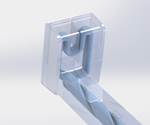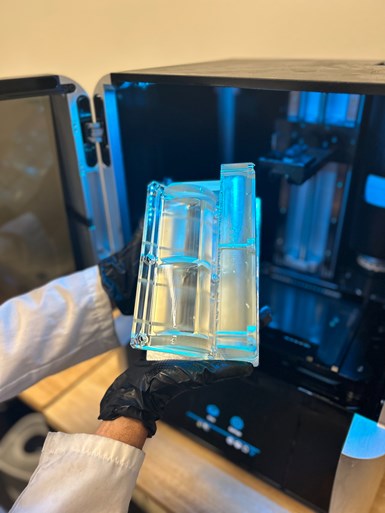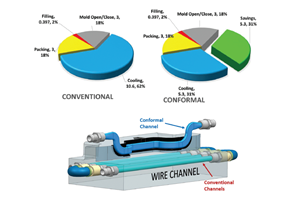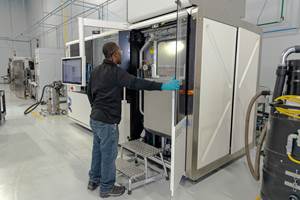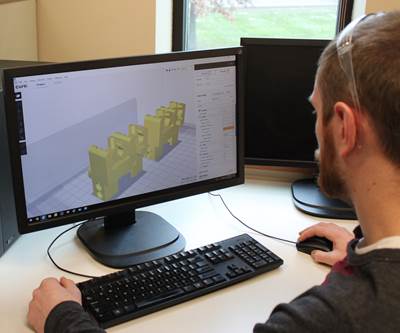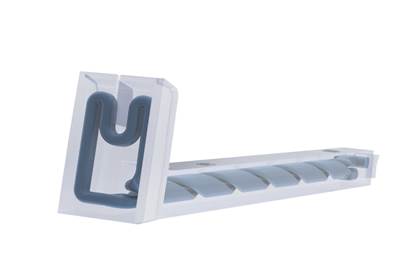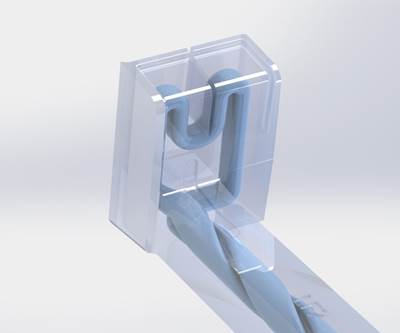Alpine Advanced Materials delivered 80 rapid prototype molded (RPM) parts (depicted above) for low-volume injection molding production within 10 business days using the freeform injection molding (FIM) process. Source | Alpine Advanced Materials
Alpine Advanced Materials (Alpine), a custom-engineering and part manufacturer in industries like aerospace and defense, space and emerging transportation, leveraged a new prototyping process utilizing a dissolvable mold for high-performance injection molded composites.
Using Nexa3D’s additive technology, Alpine was able to bridge the gap between testing and production via producing 3D printed tooling faster and more cost effectively than conventional metal mold tooling. These higher grade composite prototypes can provide the same levels of strength and durability of metal at roughly half the weight.
Implementing Nexa3D’s XiP desktop 3D printer to complement the freeform injection molding (FIM) process, Alpine was able to produce the high-performance injection molded composite parts on a rapid timeline and deliver an even wider selection of scalable and flexible manufacturing services to its customers.
In delivering a prototype solution for small quantities mirroring the performance expectations in production injection molded parts prior to the full investment in the production mold, Alpine enables users to test the design before they invest in a higher volume solution.
The Challenge
The truth is, conventional tooling methods are costly. According to Alpine, the traditional approach to injection molding requires a large upfront investment in permanent steel tooling, but this doesn’t always align with where customers are in their development and production journey.
While the benefits of high-volume manufacturing of advanced materials delivers great value to customers, it can also prove challenging for manufacturers ramping up a new design.
“Our customers are looking for scalable solutions to production,” says David Brantner, CEO of Alpine Advanced Materials. “They are looking to us to take them from design, to prototype to high-volume production.”
With permanent steel tooling, there is limited ability to rapidly produce prototype parts for quick testing and validation. Additionally, iteration upon a design after a steel tool has been fabricated is limited and costly, leaving no room for error.
For advanced injection molding materials, such as HX5, a multiscale reinforced polymer to which Alpine has the exclusive rights, it can be even more difficult to develop optimized part designs and mold tooling without alternatives to steel. With Alpine’s new additive approach to prototyping, materials like HX5 that are typically injection molded from steel tooling can now alternately be made via FIM.
“Another challenge our customers are dealing with is finding ways to simplify their supply chain,” says Brantner.
The current supply chain for high-performance injection molded parts can be tricky to navigate for different reasons. For example, when it comes to sourcing high-performance materials, there are many decisions facing both manufacturers and customers. Cost and availability are just two factors that must be taken into consideration.
3D printed tooling can be an alternative to steel for rapid prototyping of injection molds. Unfortunately, standalone 3D printing can be costly and many nonmetal printed tools cannot withstand the extremely high molding temperatures of composite polymers.
How then can customers and manufacturers find a process to achieve simpler parts at a higher scale?
A Hybrid Solution: The FIM Process
In searching for solutions to customers’ needs for functional prototypes, Alpine realized a combination of 3D printed tooling and injection molding had the potential to yield end-use parts without the significant tooling investment. FIM leverages 3D printing’s speed and design flexibility along with a tooling material capable of molding high-performance polymers such as HX5.
Utilizing a Nexa3D proprietary material and the XiP desktop resin printer, Alpine now uses FIM, a process originally developed by the Danish company Addifab before the company was acquired by Nexa3D. FIM offers the dual benefits of design freedom for injection mold tooling through resin 3D printing and mechanical performance through a specially formulated tooling resin, xMold, that can withstand the molding of high-performance materials.
The FIM process can be summarized in just three words: print, inject and dissolve.
Print: FIM is a process created specifically for injection mold toolmaking and therefore offers high precision, tight tolerances and almost unlimited design freedom. This is largely due to the dissolvable xMold resin that is used to shape the mold tooling. The resin is compatible with hundreds of injection moldable plastics, including some reinforced feedstocks.
The process is supported by Nexa3D’s XiP 3D printers, but it is also compatible with other resin-based printers. 3D printing produces a negative mold which is then placed inside the cavity of the tool.
Inject: From here, the printed mold can be used with any injection molding machine that accommodates required injection pressures and temperatures. The molding tools themselves are compatible with conventional injection molding feedstock materials such as composites, thermoplastics, silicones and metals, including specialty materials such as HX5.
RPM is an all-in-one prototyping solution from Alpine in which a negative cavity of the part is 3D printed using a dissolvable resin, then injected with a high-performance thermoplastic material, resulting in a prototype that is fast, inexpensive and high quality. The image depicts an RPM mold fresh off of the 3D printer. Source | Alpine Advanced Materials
After the negative mold is 3D printed and placed inside the cavity of the tool, Alpine shoots the given material into the mold which results in the resin hardening. But rather than ejecting the component from the injection mold tool (as seen in the traditional demolding process), the part is removed from the tool still embedded inside the negative mold.
Dissolve: The last step is to dissolve the soluble injection mold tool to release the injection molded part.
The process involves submerging the filled tool in an alkaline water solution for anywhere between 12-48 hours depending on part size and complexity.
Benefits from FIM
To be clear, Alpine isn’t an FIM company. Rather, the FIM process was adopted out of necessity to convince customers of the value of metallic to nonmetallic conversion prior to investing in a very expensive production tool. With 3D printed tooling, Alpine can support more generative design and feedback implementation and quickly deliver parts while also giving customers confidence in the final tool design.
“Basically, we let our customers know that we can make the very same part they are struggling to obtain via traditional steel tooling in our advanced thermoplastic. While the unit cost of the prototype will be more than that of full production volumes, we can place parts in the hands of our customers much quicker than traditional manufacturing methods,” says Brantner.
The upfront cost takes into account the simplified supply chain, the ability to test tooling and make adjustments with ease (courtesy of the FIM process) and ultimately the quicker turnaround time in which Alpine is able to generate and place tooling into its customers’ hands.
When Alpine uses the FIM process to create an injection molded tool, the customer has the opportunity to see the result and be fully satisfied with it before making a large investment in the production tool. Using this process, a mold can be designed in just one to two days and then take only a single day to print.
The company says this rapid prototyping process de-risks the path to using and exploring new thermoplastic materials for high-performance components. Cracking the code to these thermoplastic materials opens new doors for customers in terms of validation testing, product demonstration and for some, small quantities of initial production.
Case Study Results
The short time frame afforded by the FIM process proved useful when a defense firm from Huntsville, Alabama, came to Alpine for the rapid production of parts to perform a demonstration of an unmanned aerial vehicle (UAV) system. The defense firm needed parts with strength higher than those achievable solely through polymer 3D printing, but its own metal machining capacity was exhausted and could not deliver the parts.
Within a three-week timeframe, the customer needed rapidly produced, yet quality injection molded parts.
Alpine implemented the FIM process to design, print, mold and deliver all 60 of the required parts for the customer after 10 business days. The demonstration was successful in utilizing the quickly produced parts.
The partnership between Alpine Advanced Materials and Nexa3D has opened new doors to unlimited design freedom in the manufacturing industry.
By leveraging Nexa3D technology and equipment, Alpine has been able to address the challenges associated with traditional metal tooling. The FIM process itself has made it possible for Alpine to complete rapid prototyping, enhance part strength, surface finish and durability, de-risk material innovation and most importantly, cut down on costs and previously problematic time constraints.
The FIM process breaks down barriers between customers and manufacturers, enabling a safe way to experiment with advanced engineering and materials alike.
As of now, Alpine is working to improve the ways it is leveraging FIM and address some of the challenges that come with this process, one of which is the continued need to scale up tool sizes in order to meet the needs of customers in need of larger parts. Another is the amount of resin being wasted in the creation for one tool, (as the FIM process is a form of sacrificial tooling).
Alpine is exploring alternative methods to produce medium-volume parts out of a single 3D printed mold. The company continues to search for additional advanced additive manufacturing methods to ensure it is meeting the needs of its customers regardless of volume requirements.
Related Content
Mold Materials, 3D Printing Technologies for Next-Gen Moldmaking
As moldmaking advances, so too do the materials and processes involved in their efficient production, including these latest mold materials and 3D printing technologies.
Read MoreBuilding Molds: Most Popular Reads of 2024
Dive into the most-viewed content for building your mold, including topics such as cutting tools, EDM, hot runners, additive manufacturing, mold materials, machining and mold components.
Read MoreHow to Use Thermal Management to Improve Mold Cooling
A review of common mold cooling issues and possible solutions, including 3D printing applications.
Read MoreThe Benefits of Vertically Integrating Metal 3D Printing and Machining
Having 3D printing and machining within one organization enables Addman’s engineers to collaborate and consolidate so it can quickly make successful metal 3D-printed parts.
Read MoreRead Next
Putting 3D Printing to Work
Micro Mold and Plastikos together have invested more than $400,000 in technologies and processes related to 3D printing and reverse engineering over the last three years.
Read MoreHow to Design a Mold with Additive Tooling
Designing molds with additive tooling implementation in mind requires blending traditional mold standards with innovative new ideas of what is possible to push the limits of mold performance.
Read MoreSelling the Value of Additive Tooling in a Mold
Gaining molder buy-in for a conformal-cooled mold insert requires communicating the mold’s total cost of ownership over the life of the project.
Read More




